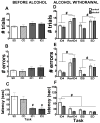Effects of chronic intermittent ethanol exposure on orbitofrontal and medial prefrontal cortex-dependent behaviors in mice
- PMID: 22122149
- PMCID: PMC3229192
- DOI: 10.1037/a0025922
Effects of chronic intermittent ethanol exposure on orbitofrontal and medial prefrontal cortex-dependent behaviors in mice
Abstract
In humans, stroke or trauma-induced damage to the orbitofrontal cortex (OFC) or medial prefrontal cortex (mPFC) results in impaired cognitive flexibility. Alcoholics also exhibit similar deficits in cognitive flexibility, suggesting that the OFC and mPFC are susceptible to alcohol-induced dysfunction. The present experiments investigated this issue using an attention set-shifting assay in ethanol dependent adult male C57BL/6J mice. Ethanol dependence was induced by exposing mice to repeated cycles of chronic intermittent ethanol (CIE) vapor inhalation. Behavioral testing was conducted 72 hours or 10 days following CIE exposure to determine whether ethanol-induced changes in OFC-dependent (reversal learning) and mPFC-dependent (set-shifting) behaviors are long lasting. During early ethanol abstinence (72 hrs), CIE mice showed reduced reversal learning performance as compared to controls. Reversal learning deficits were revealed as greater number of trials to criterion, more errors made, and a greater difficulty in performing a reversal learning task relative to baseline performance. Furthermore, the magnitude of the impairment was greater during reversal of a simple discrimination rather than reversal of an intra-dimensional shift. Reversal learning deficits were no longer present when mice were tested 10 days after CIE exposure, suggesting that ethanol-induced changes in OFC function can recover. Unexpectedly, performance on the set-shifting task was not impaired during abstinence from ethanol. These data suggest reversal learning, but not attention set-shifting, is transiently disrupted during short-term abstinence from CIE. Given that reversal learning requires an intact OFC, these findings support the idea that the OFC may be vulnerable to the cognitive impairing actions of ethanol.
PsycINFO Database Record (c) 2011 APA, all rights reserved.
Figures




References
-
- Ahveninen J, Jääskeläinen IP, Pekkonen E, Hallberg A, Hietanen M, Näätänen R, Sillanaukee P. Global field power of auditory N1 correlates with impaired verbal-memory performance in human alcoholics. Neuroscience Letters. 2000;285(2):131–4. - PubMed
-
- Badanich KA, Becker HC, Woodward JJ. Neuroscience Meeting Planner. San Diego, CA: Society for Neuroscience; 2010. Effects of acute and chronic intermittent ethanol exposure on neuron excitability in the orbitofrontal cortex. Program No. 473.12/JJ8. 2010.
-
- Becker HC, Lopez MF. Increased ethanol drinking after repeated chronic ethanol exposure and withdrawal experience in C57BL/6 mice. Alcoholism Clinical and Experimental Research. 2004;28(12):1829–38. - PubMed
-
- Bijl S, de Bruin EA, Kenemans JL, Verbaten MN, Böcker KB. Effects of chronic alcohol consumption in a visual attention task and an auditory oddball task: an event-related potential study. Alcoholism Clinical and Experimental Research. 2005;29(11):2029–38. - PubMed

